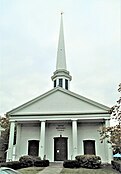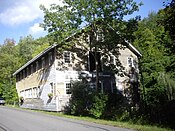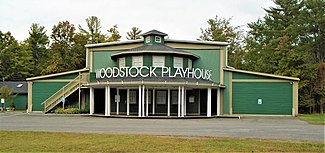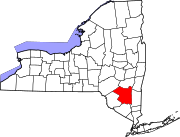Woodstock, New York
Woodstock, New York | ||
|---|---|---|
FIPS code 36-83052[2] | | |
| GNIS feature ID | 0979655[3] | |
| Website | www | |
Woodstock is a
History
The first non-indigenous settler arrived around 1770, and the town of Woodstock was established in 1787. Later, territory from Woodstock was contributed to form the towns of
]Woodstock played host to numerous
A series of
Woodstock is also home to the Karma Triyana Dharmachakra Buddhist monastery, situated at the top of Mead's Mountain Road.
Geography
According to the United States Census Bureau, the town has a total area of 67.8 square miles (175.7 km2), of which 67.3 square miles (174.3 km2) is land and 0.54 square miles (1.4 km2), or 0.80%, is water.[11]
The northern town line is the border of Greene County.
Demographics
| Census | Pop. | Note | %± |
|---|---|---|---|
| 1820 | 1,317 | — | |
| 1830 | 1,376 | 4.5% | |
| 1840 | 1,691 | 22.9% | |
| 1850 | 1,650 | −2.4% | |
| 1860 | 1,858 | 12.6% | |
| 1870 | 2,022 | 8.8% | |
| 1880 | 1,968 | −2.7% | |
| 1890 | 1,628 | −17.3% | |
| 1900 | 1,675 | 2.9% | |
| 1910 | 1,647 | −1.7% | |
| 1920 | 1,488 | −9.7% | |
| 1930 | 1,652 | 11.0% | |
| 1940 | 1,983 | 20.0% | |
| 1950 | 2,271 | 14.5% | |
| 1960 | 3,836 | 68.9% | |
| 1970 | 5,714 | 49.0% | |
| 1980 | 6,823 | 19.4% | |
| 1990 | 6,290 | −7.8% | |
| 2000 | 6,241 | −0.8% | |
| 2010 | 5,884 | −5.7% | |
| 2020 | 6,287 | 6.8% | |
| U.S. Decennial Census[12] | |||
As of the
There were 2,946 households, out of which 21.7% had children under the age of 18 living with them, 44.2% were married couples living together, 7.9% had a female householder with no husband present, and 44.8% were non-families. 35.5% of all households were made up of individuals, and 10.6% had someone living alone who was 65 years of age or older. The average household size was 2.10 and the average family size was 2.71.
In the town, the population was spread out, with 18.0% under the age of 18, 3.7% from 18 to 24, 23.0% from 25 to 44, 38.0% from 45 to 64, and 17.3% who were 65 years of age or older. The median age was 48 years. For every 100 females, there were 94.7 males. For every 100 females age 18 and over, there were 93.1 males.
The median income for a household in the town was $49,217, and the median income for a family was $65,938. Males had a median income of $41,500 versus $33,672 for females. The
Music and art
The town is famous for lending its name to the
The 1903
In 1916,
The town is home to the Woodstock Artists Association and Museum (WAAM), founded in 1919 by John F. Carlson, Frank Swift Chase, Andrew Dasburg, Carl Eric Lindin, and Henry Lee McFee.[16] The WAAM Permanent Collection features work by important American artists associated with the region, including Milton Avery, George Bellows, Edward Leigh Chase, Frank Swift Chase, Florence Ballin Cramer, Arnold Blanch, Doris Lee, Marion Greenwood, Philip Guston, Yasuo Kuniyoshi, Paul Meltsner, and many others. The Art Students League of New York's summer school was in Woodstock from 1906 until 1922, and again after World War II, from 1947 until 1979. The Woodstock School of Art has been operating since 1980.

The Woodstock Guild, founded by Byrdcliffe artists in 1939, is now the steward of the 350-acre (1.4 km2) Byrdcliffe Colony. It is a
In 1981, the town hosted the
, among others.On April 19–22, 2012, Woodstock hosted the Woodstock Writers Festival. Ann Hood, Augusten Burroughs, Shalom Auslander, Kurt Andersen and Ned Leavitt spoke and offered workshops on a variety of topics related to literature.
Woodstock is the home of the Woodstock Film Festival, founded in 2000. The Woodstock Film Festival is an Oscar®-qualifying festival in the short film categories - Live Action Short Film, Animated Short Film, and Documentary Short Film.
Notable people
The town has long been a mecca for artists, musicians, actors, and writers, even before the music festival made the name "Woodstock" famous. The town has a separate "Artist's Cemetery". Film and art festivals attract big names, and hundreds of musicians have come to Woodstock to record. Among the major musicians were the pioneer, Bob Dylan, followed by, among others, Joe Cocker. All those musicians were performing in a bar which became world-famous, the Joyous Lake.
Let us notice another Woodstock luminary: Lee Marvin, who was employed at the Woodstock Heckeroth Plumbing Company; one day, the main actor of the defunct Woodstock Theater was sick, somebody suggested to call Lee Marvin as a replacement, and his acting career was on the track.
Local communities and landmarks
- Artists' Cemetery – A cemetery for Woodstock artists and luminaries on Rock City Road.
- Ashokan Reservoir – A New York City reservoir under which lies nine lost towns.
- Bearsville – A hamlet at the junction of Routes 212 and 45, west of Woodstock village.
- Byrdcliffe – Site of the original art colony east of the junction of Routes 212 and Glasco Turnpike (County Road 33), northwest of Woodstock village on the lower slopes of Mount Guardian above Glasco Turnpike. At one time it was home for the Turnau Opera and now the Byrdcliffe Theater.
- Church of the Holy Transfiguration of Christ-on-the-Mount.
- Cooper Lake – Kingston reservoir located south of Lake Hill, northwest of Bearsville and west by northwest of Shady.
- Daisy – A hamlet east of Woodstock in Saugerties associated with Woodstock through the Woodstock Jewish Congregation, sometimes called East Woodstock;[18] here it is said are the most "documented" stone cairns, mounds and other possible ancient sites associated with Woodstock folklore traditions. Many of those are threatened by development.
- Echo Lake – A mountain lake within the Indian Head Wilderness of the Catskill Mountains.
- Judge Jonathan Hasbrouck House listed on the National Register of Historic Places in 2013.[19]
- Lake Hill - A hamlet just west of Shady
- Mead's Meadow (Woodstock) – Formerly a cow pasture, "The Magic Meadow" is a quarter mile past the summit of Mead Mountain Road and the Buddhist monastery. It is an entrance to the Devil's Path.
- Montoma – A hamlet south of Woodstock near the town line with the Town of Hurley.
- Mount Guardian – A mountain to the west of Overlook Mountain, below which is the hamlet of Shady.
- Mount Tobias – A mountain in the central part of the town.
- National Youth Administration Woodstock Resident Work Center
- Ohayo Mountain – A mountain to the south, between the Ashokan Reservoir and Woodstock village, bordering West Hurley.
- Opus 40 – a large free-form sculpture carved out of the local bluestone by Harvey Fite in the Saugerties hamlet of High Woods, four miles from the central Woodstock hamlet.[20]
- Overlook Mountain – A mountain to the northeast, on whose lower slopes much of Woodstock is situated.
- Phoenicia, NY - hamlet of Shandaken in Ulster County, New York - 13.5 miles west of Woodstock.
- Saugerties, New York – A nearby town that includes the 800-acre Winston Farm, a proposed site for Woodstock '69 and home to Woodstock '94,[20]and host to the Garlic Festival and Horse Shows In The Sun (HITS) north of the village.
- Saw Kill – A stream that rises in Echo Lake, flows west through Shady, then south to Bearsville, east to Woodstock, and southeast to Zena on the way to its confluence with the Esopus Creek near Kingston.
- Shady – A hamlet northwest of Byrdcliffe, past the intersection of Glasco Turnpike and Route 212.
- Vosburg Turning Mill Complex
- Willow – A hamlet in the northwest part of the town on Route 212.
- Wittenberg – A hamlet at the junction of Routes 45, southwest of Bearsville. It contains Yankeetown Pond and Kenneth Wilson State Campground.
- Woodstock – The hamlet of Woodstock and the principal center of local services for the town.
- Zena – A hamlet east of Woodstock hamlet in the southeast part of the town.
Gallery
-
Dutch Reformed Church (1799)
-
NRHP)
-
Vosburg Turning Mill Complex (NRHP)
-
Tinker Street
See also
References
- ^ "2016 U.S. Gazetteer Files". United States Census Bureau. Retrieved July 5, 2017.
- ^ a b "U.S. Census website". United States Census Bureau. Retrieved January 31, 2008.
- ^ "US Board on Geographic Names". United States Geological Survey. October 25, 2007. Retrieved January 31, 2008.
- ^ "Explore Census Data". data.census.gov. Retrieved January 30, 2023.
- ^ Applebome, Peter (August 13, 2009). "50 Miles and 40 Years From Yasgur's Farm, Town of Woodstock Tries to Move On". The New York Times.
- ^ "The Maverick Festival of Woodstock". newpaltz.edu.
- ^ Vernon Benjamin, The History of the Hudson River Valley, 1865-2015, forthcoming from Overlook Press
- ^ "The Real Woodstock". The Attic. Retrieved November 5, 2019.
- ^ "The Story of the Woodstock Music Festival". bellaonline.com.
- ^ Arts, Bethel Woods Center for the. "About Us - Bethel Woods Center for the Arts". www.bethelwoodscenter.org.
- ^ "Geographic Identifiers: 2010 Demographic Profile Data (G001): Woodstock town, Ulster County, New York". U.S. Census Bureau, American Factfinder. Archived from the original on February 12, 2020. Retrieved June 17, 2014.
- ^ "Census of Population and Housing". Census.gov. Retrieved June 4, 2015.
- ^ See Tom Wolf, "Byrdcliffe's History: Industrial Revolution," in Byrdcliffe: An American Arts and Crafts Colony (Ithaca: Herbert F. Johnson Museum of Art, 2004), pp. 16–35
- ^ "Maverick Concerts History". maverickconcerts.org.
- ^ Wolf, Tom and Rhoads, William B. "The Maverick: Hervey White's Colony of the Arts" (Woodstock Artists Association and Museum, 2006), pp. 11-31.
- ^ Wolf, tom.Woodstock's Art Heritage: The Permanent Collection of the Woodstock Artists Association (Woodstock: Overlook Press, 1987).
- ^ "Byrdcliffe Theater". Ulster County NY Tourism. Archived from the original on February 9, 2023. Retrieved March 1, 2024.
- ^ Vernon Benjamin, The History of the Hudson River Valley 1865-2015
- ^ "National Register of Historic Places Listings". Weekly List of Actions Taken on Properties: 3/04/13 through 3/08/13. National Park Service. March 15, 2013.
- ^ a b Vernon Benjamin, The History of the Hudson River Valley: 1865-2015







